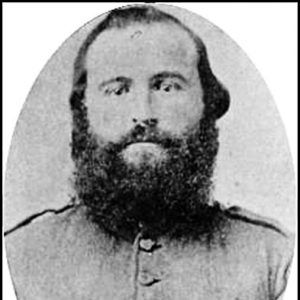calsfoundation@cals.org
James McQueen McIntosh (1828–1862)
James McQueen McIntosh served as a Confederate colonel in the Second Arkansas Mounted Rifles and as a brigadier general before losing his life at the Battle of Pea Ridge.
James McIntosh was born at Fort Brooke, near present-day Tampa, Florida, in 1828. His father was Colonel James Simmons McIntosh of the U.S. Army. The elder McIntosh served in both the War of 1812 and the Mexican War, during which he was killed at the 1847 Battle of Molino del Rey. The younger McIntosh graduated last in his class the next year from the United States Military Academy at West Point.
Serving on active duty with the U.S. Army on the western frontier, McIntosh was promoted to captain of the First Cavalry in 1857. At the outbreak of the Civil War in 1861, McIntosh was stationed at Fort Smith (Sebastian County). He resigned his federal commission when his native Florida seceded, and subsequently he was given command of the Second Arkansas Mounted Rifles.
The regiment joined other Confederate forces organizing near Fort Smith under the command of Brigadier General Benjamin McCulloch, and they moved into southern Missouri, where they joined Missouri State Guard forces under Sterling Price and Arkansas State Troops commanded by Nicholas Bartlett Pearce. They were attacked by a Federal army under the command of Brigadier General Nathaniel Lyon at Wilson’s Creek on August 10, 1861; the combined Confederate force defeated its Union opponent. During the battle, McIntosh commanded McCulloch’s brigade of Confederate troops, while McCulloch commanded the entire army.
Eventually, the Confederate and Arkansas forces moved southward back into the state, while Price and his Missourians moved into central Missouri in an effort to gather recruits and supplies. In the winter of 1861–62, McIntosh moved against pro-Union Native Americans in the nearby Indian Territory. The Native Americans were attempting to flee to Federal-held Kansas, while troops under McIntosh and Colonel Douglas Cooper worked together to stop them. Under the command of Muscogee (Creek) chief Opothleyahola, the Indians defeated a Confederate force led by Colonel Douglas Cooper on November 19, and McIntosh’s brigade was dispatched for support. Cooper won a small victory at the December 9 Battle of Chusto-Talasah but endeavored to completely drive the enemy from the territory. The two commands planned to attack the enemy from different directions, but shortly before the attack, Cooper informed McIntosh that his men would not be ready in time. The Creek and their allies were at Chustenahlah, and McIntosh arrived on the field on December 25, 1861. McIntosh attacked on December 26 without support and successfully drove the enemy from the field. The Native Americans who escaped were able to reach Kansas and did not pose a threat to Confederate forces in the Indian Territory for the remainder of the war. In recognition of his success at Wilson’s Creek and Chustenahlah, McIntosh was promoted to brigadier general on January 24, 1862.
The command structure of Confederate forces in the Trans-Mississippi was not clear during this period, as McCulloch and Price did not work well together. Major General Earl Van Dorn was transferred west to take command of the department. Moving to meet a Federal invasion of northwestern Arkansas led by Major General Samuel Ryan Curtis, Van Dorn commanded the entire Confederate force, while McCulloch and Price each commanded a division. Encountering Union forces near Pea Ridge (Benton County), Van Dorn attacked on March 7, 1862. While scouting a Federal position near Leetown (Benton County), McCulloch was killed by enemy fire. Command of the division passed to the senior brigade commander, McIntosh. Within minutes, McIntosh was also killed by Federal fire, and confusion spread through the division, as the remaining commanders did not take command. Eventually, the Union forces under Curtis prevailed, and the Confederates retreated.
The bodies of McIntosh and McCulloch were taken to Fort Smith, where they were buried in the Fort Smith National Cemetery. McIntosh’s younger brother, John Baillie McIntosh, served as a major general with the Union army during the war.
For additional information:
Warner, Ezra. Generals in Gray. Baton Rouge: Louisiana State University Press, 1959.
The War of the Rebellion: A Compilation of the Official Records of the Union and Confederate Armies. Series 1, Vols. 3, 8. Washington DC: Government Printing Office, 1889.
David Sesser
Henderson State University






Comments
No comments on this entry yet.